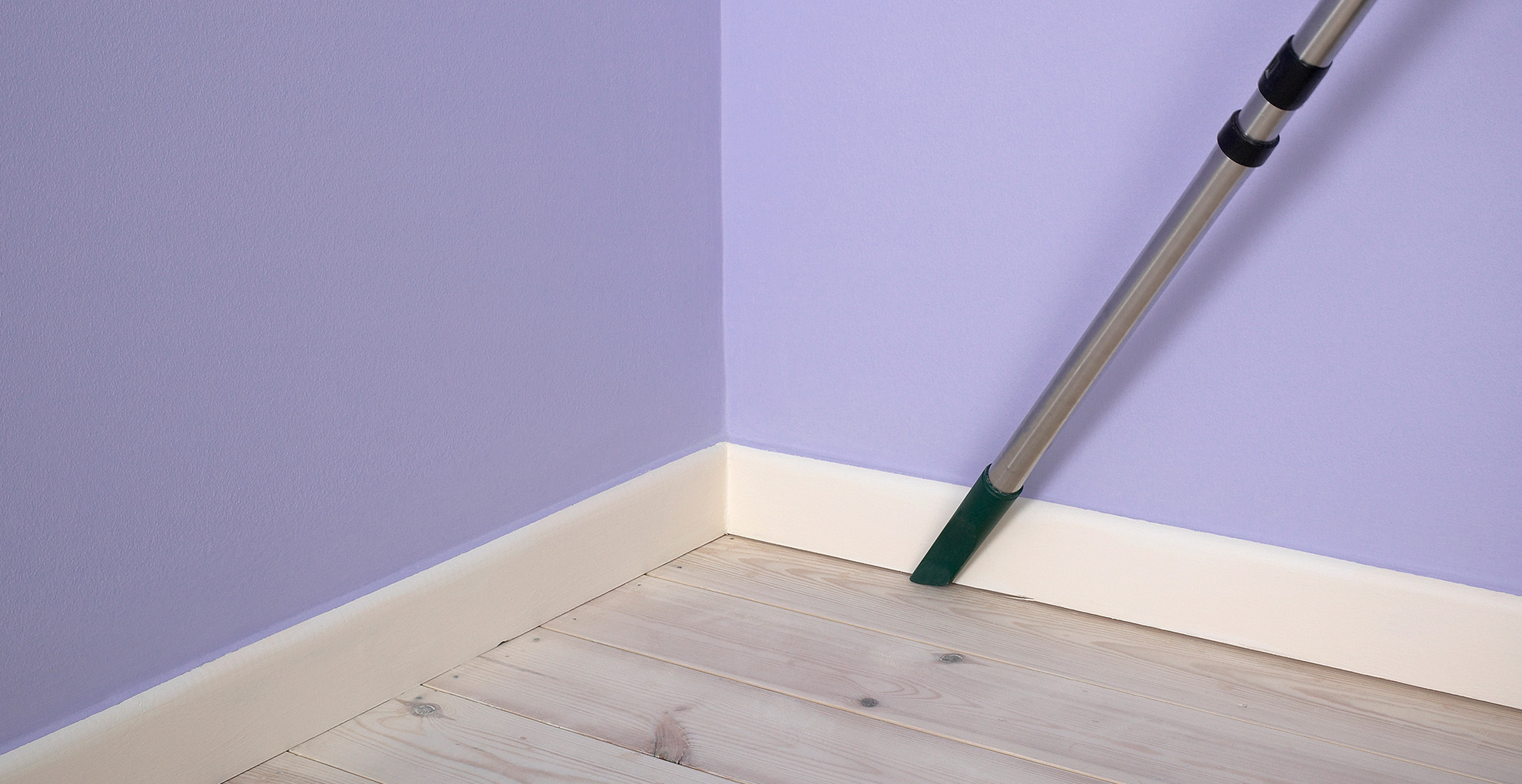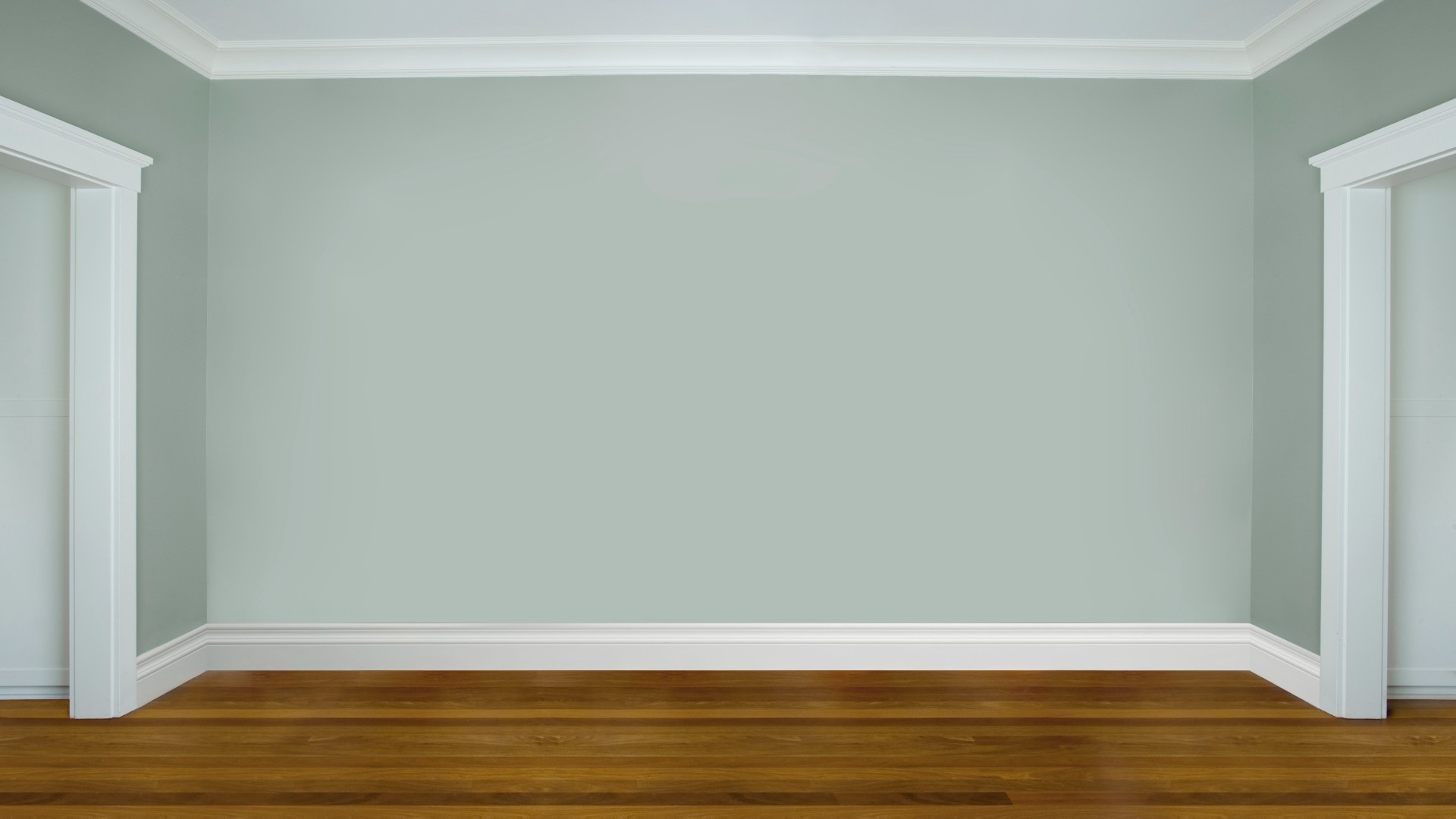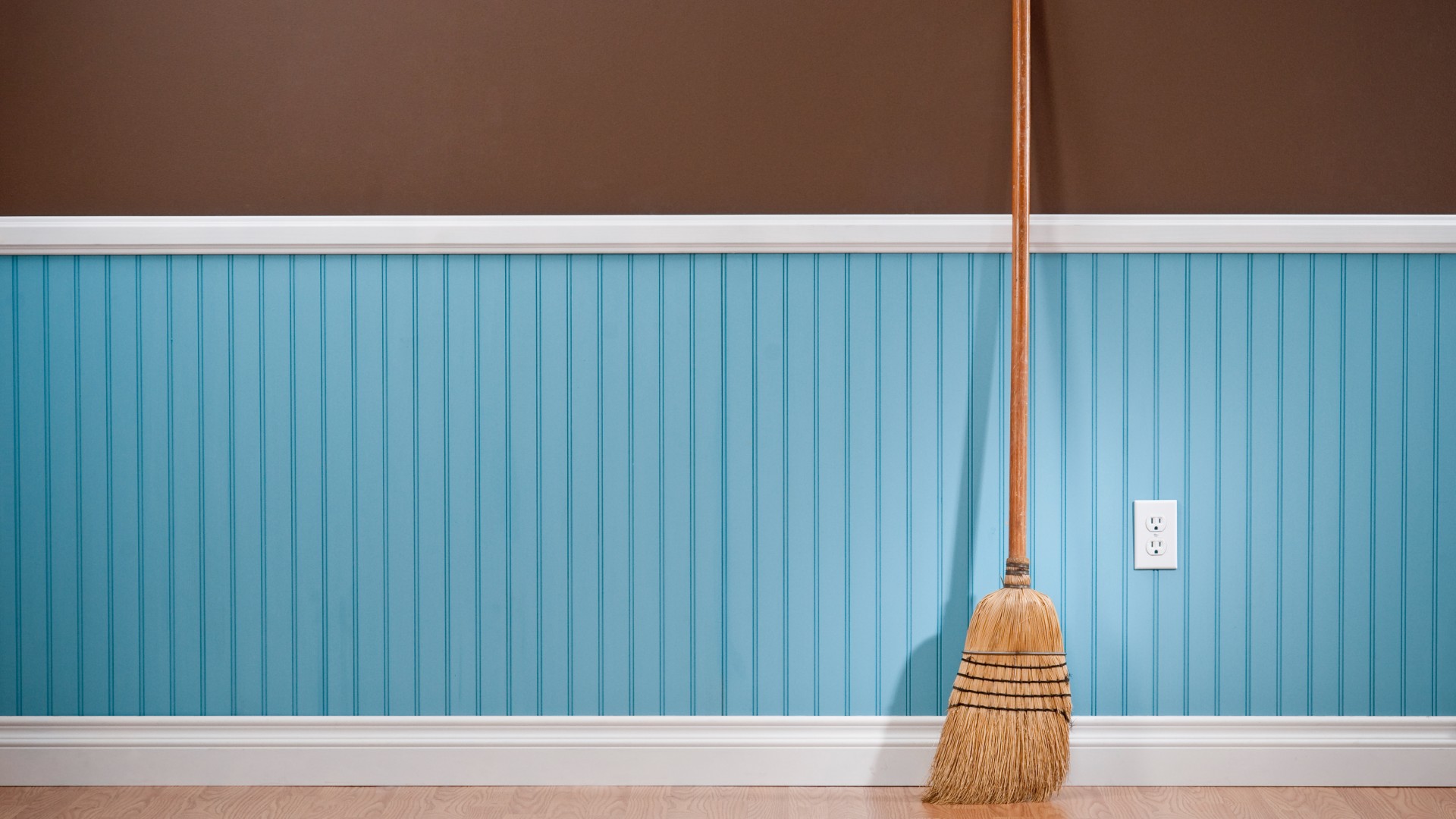
Knowing how to clean your skirting boards is important for maintaining a clean, tidy, and hygienic home – and avoiding having to repaint them due to discolouration from dirt buildup.
From accidental spills when carrying drinks around the house, dust build-up, hurried scuff marks from passersby, and children's sticky fingerprints, it's not hard to see why our skirting boards can quickly become grubby and should be factored into your routine when cleaning your house.
Luckily, while it may not be a task that's high on your to-do list when it comes to spring cleaning your home, cleaning your skirting boards is easier to achieve than you might think – especially with the right tools.
This is our expert guide explaining how to clean skirting boards properly to keep them dust and dirt free at all times.
How to clean skirting boards: in 6 simple steps
When it comes to cleaning skirting boards, it's a task that most of us put off, similar to cleaning walls. However, it's an important job, so we've spoken to experts to find out how it should be done properly.
"It's not uncommon for weekly cleaning checklists to omit cleaning skirting boards," says Nigel Barman, owner of the cleaning company Daily Poppins. But we consider this a cleaning mistake because the longer they go unnoticed the dirtier they become and therefore the harder they are to clean.
"If you look closely, you'll often find grime, scratches, and scuff marks all along your skirting boards. You may find that your previously white skirting boards have become yellow and dingy as a result of all that building up. But when it comes to how to clean skirting boards, if you have the right supplies and follow a step-by-step procedure, it isn't difficult."
Here's what you'll need:
- Soft bristled brush
- Microfibre cloth or sponge
- A bucket of warm water
- Mild detergent or multipurpose cleaner
- A towel or clean cloth for drying
- Optional: Cotton swabs
- Optional: Vacuum cleaner with brush attachment
1. Prepare the area
Similar to how you would declutter your home prior to cleaning a room, it's important to clear the area before you get stuck into cleaning your skirting boards.
Any large objects near your skirting boards, which is likely to be furniture, need to be moved to the middle of the room. This may seem like an obvious step, but many people try to just clean around objects. Not only does this leave dirt under the objects themselves, but it also means you'll have a huge amount of dirt built up on the skirting boards behind them.
Lily Cameron, cleaning expert at Fantastic Services says, "Remove any furniture or objects near the skirting boards to ensure easy access and prevent any damage or obstructions during the cleaning process."
2. Remove dust and debris

Before you use any wet cleaning solution to clean your skirting boards, first you want to dust them to make sure they're free of debris. This step makes the next step easier, like when cleaning blinds because otherwise you are diluting the dust and making it more of a problem.
"Use your soft-bristled brush to remove any dust, cobwebs, and loose dirt from the skirting boards first," advises Sarah Dempsey, a cleaning expert at MyJobQuote. "To do this, gently brush the length of the boards. Don’t forget to get into all of the corners and crevices where dust, dirt, and cobwebs may be lurking."
However, Lily adds that you can also use your vacuum cleaner's soft brush attachment for this step "to sweep the dust away." Alternatively, you can use the longer-nozzled attachment to save you from bending down to do this step.
3. Prepare your cleaning solution
Once your skirting boards are dust-free, you're ready to clean them properly. First up, you need to mix and prepare your wet cleaning solution in a bucket.
Luckily, this is easy and doesn't require an expensive, skirting board-specific cleaning solution. In fact, you probably already have what you need sitting under your organized kitchen sink area.
Sarah explains, "Fill a bucket with warm water and add a small amount of detergent or multipurpose cleaner. Be careful not to add too much as this could leave some residue behind on the baseboards. Gently mix the solution until it’s combined."
4. Get cracking with cleaning

Now you have your cleaning solution all mixed up, you're ready to clean your skirting boards. Sarah says, "Dip a clean microfibre cloth or sponge into the solution and squeeze out any excess water.
"Then, start at one end of the skirting boards and wipe along the length with gentle, sweeping motions. Pay close attention to any scuff marks, stains, or grime."
She adds, "However, avoid scrubbing too hard as this could damage the baseboards. Make sure to rinse the cloth or sponge as you go along as well, to remove any dirt."
One more thing to note is to make sure not to use too much water, as Lily warns, "excessive moisture can cause damage to the skirting boards." Similar problems can arise while cleaning hardwood floors or cleaning laminate floors.
5. Carry out one final rinse
Once you've removed all the dirt and any stubborn stains, it's time to rinse your skirting boards with clean water. This is an important step, as leaving a residue-cleaning solution on your skirting boards can damage them over time.
Lily advises, "After cleaning, rinse your cloth or sponge in clean water and wring it out thoroughly. Go over the baseboards again to remove any residue from the detergent or cleaning solution."
6. Allow for drying time

Now you've removed any remaining cleaning solution, it's time to dry your skirting boards. This is another crucial step to prevent any damage to your skirting boards going forwards.
Sarah says, "Once you’ve finished cleaning the skirting boards, use a clean cloth or towel to dry them. Wipe away all of the remaining moisture and ensure the skirting boards are completely dry to avoid water damage or warping."
She adds, "Once they’re dry, inspect the skirting boards to make sure you haven’t missed any spots. If needed, repeat the cleaning process on those areas until your skirting boards are clean."
What is the best cleaning hack for skirting boards?
The best way to clean your skirting boards is via the method above. However, slight changes may need to be made depending on what material your skirting boards are made from.
While for painted skirting boards, the above steps will work well, for wooden skirting boards, Lily advises taking some extra precautions. "Avoid using excessive moisture on wood, because it can damage them," she says. "Instead, use a microfibre cloth or sponge slightly dampened with water or a mixture of water and mild wood cleaner. Wipe the skirting boards gently, following the wood grain. Immediately dry them with a clean, dry cloth to prevent any moisture absorption and warping."
Whereas for vinyl or PVC skirting boards, she says, "these materials are more durable and can withstand slightly more moisture."
One tip Lily suggests, is to always do a patch test. "Before you begin cleaning any of these skirting board materials, always test any cleaning solution or method on a small, inconspicuous area to ensure it doesn't cause damage or discolouration," she says. "To prevent that, always check and follow the manufacturer's recommendations for cleaning and maintenance as well, especially for specialised or delicate baseboard materials."

How often should you clean the skirting boards?
To avoid having to do a big clean periodically, it's best to clean your skirting boards regularly to keep them looking fresh and scuff-free.
Sarah suggests, "As a general rule of thumb, it’s recommended that you deep clean your skirting boards every three months to keep them from looking grubby. Regular dusting or wiping can help to prevent the build-up of dirt, dust, and grime and will make the deep cleaning process much easier."
The cleaning expert adds, "If you notice any visible scuff marks or dirt on the baseboards, aim to clean these off as soon as you notice them as it will likely be easier to clean off sooner rather than later."
And to avoid heavy dust build-up, Nigel says, "It is generally recommended to dust skirting boards every three to four weeks, or at least once a month, in most households."
However, like with how often you should vacuum or how often you should mop floors the timescale may vary, depending on your lifestyle.
How do you clean skirting boards without getting on the floor?
If you want to protect your knees and back and avoid bending down or lowering onto the floor, you can still clean your skirting boards by using some handy tools - such as extension tools.
Sarah explains, "You can clean your skirting boards with a long-handled tool without having to bend down or get on the floor. Some examples include a long-handled duster or a microfibre mop with an extendable handle."
She adds, "Simply attach a microfibre cloth or duster head to your tool and make sure it’s securely fastened. Dampen the cloth or spray a small amount of multipurpose cleaner on it. Starting from one end of the skirting boards, guide the tool across the length with gentle sweeping motions. You may need to rinse or change the duster or cloth during the cleaning process if dirt starts to accumulate."
You can also use your vacuum cleaner to clean your skirting boards without getting on the floor. Sarah explains, "Firstly, check to see if you vacuum cleaner has a brush attachment or a crevice tool specifically designed for cleaning skirting boards. Attach the relevant tool to your vacuum cleaner hose or wand, turn your vacuum on and run the attachment or tool along the length of the baseboard.
"Focus on removing all of the dirt, dust and cobwebs. Work slowly and methodically to ensure you get a thorough clean and make sure to pay close attention to crevices and corners. You may need to combine this cleaning method with cleaning with a damp cloth or long handled tool to ensure you can get rid of any scuffs or stains."
A mop is another way you can clean your skirting boards without bending down. Lily says, "The advantage of using a mop is that it covers a larger surface area and can clean both the baseboards and the adjacent floor at the same time."

Can you sugar soap skirting boards?
Sugar soap is a cleaning solution that’s commonly used for pre-painting preparation, but can also be used to clean skirting boards. Sugar soap can effectively remove dirt, grease, and grime from various surfaces such as skirting boards. Lily says, "Read the instructions on the sugar soap packaging and dilute it in a bucket of warm water according to the recommended ratio."
As for the method, Nigel says, "To use sugar soap on skirting or baseboards, there is a simple method. Once your sugar soap solution is prepared, you'll need a small sponge - a sponge kitchen scourer works well. For general cleaning, you can use the sponge, while if there is a stubborn spot, you can use the scourer. As an alternative, use an absorbent cloth rather than paper towels."
He continues, "The sponge or cloth should be dipped in the solution, squeezed to remove some of the solution, and then wiped from side to side and moved downward. When the area has been cleaned with sugar soap, take a clean cloth and rinse it with warm water and allow it to dry."







